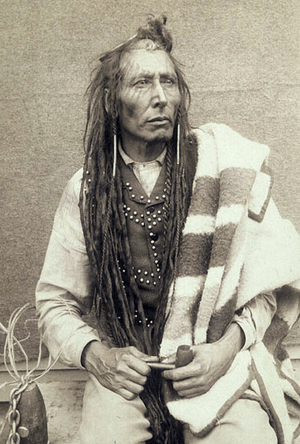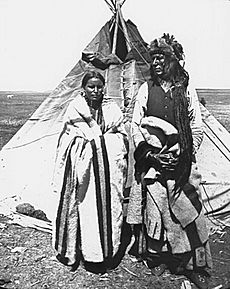Poundmaker facts for kids
Quick facts for kids Poundmaker |
|
|---|---|
| Cree headman | |

Chief Poundmaker (1885)
|
|
| Born | Pîhtokahanapiwiyin 1842 near Battleford, Rupert's Land, British North America |
| Died | 4 July 1886 (aged 43–44) Blackfoot Crossing, Alberta, North-West Territories, Canada |
| Father | Sikakwayan |
Pîhtokahanapiwiyin (born around 1842 – died July 4, 1886), also known as Poundmaker, was an important Plains Cree chief. He was known for being a peacemaker and for protecting his people, the Poundmaker Cree Nation. His name came from his special skill at guiding buffalo into special enclosures called buffalo pounds.
In 1885, during a conflict known as the North-West Rebellion, Canadian soldiers attacked his group of people. A battle happened. After the conflict ended, Poundmaker gave himself up. He was found guilty of a serious crime against the government and put in prison. Sadly, he died from an illness soon after he was released. In May 2019, the Canadian Prime Minister Justin Trudeau officially cleared Poundmaker's name and apologized to the Poundmaker Cree Nation.
Contents
Understanding Poundmaker's Name
According to the traditions and stories of the Cree people, Pîhtokahanapiwiyin got his name, Poundmaker, because he was very good at attracting buffalo into "buffalo pounds." A buffalo pound was like a huge fenced area. Its walls were covered with thick bushes.
Usually, large groups of buffalo were scared into these traps. But sometimes, a person like Pîhtokahanapiwiyin could draw them in. The stories say he had special spirit helpers. He would sing and drum a special song. This would encourage a lead buffalo cow to guide her herd into the enclosure.
Poundmaker's Early Life and Leadership
Poundmaker was born around 1842 in Rupert's Land. This area is near where the town of Battleford is today. His father, Sikakwayan, was an Assiniboine medicine man. His mother was a Cree woman and the sister of Chief Mistawasis.
After his parents passed away, Poundmaker, his brother (Yellow Mud Blanket), and his younger sister were raised by their mother's Cree community. This community was led by Chief Wuttunee, who later became known as the Red Pheasant Band.
As an adult, Poundmaker became well-known during the talks for Treaty 6 in 1876. He then formed his own group of people. In 1881, his group settled on a reserve. This land was about 40 kilometers northwest of Fort Battleford. Poundmaker was not against the idea of a treaty. However, he became critical because the Canadian government did not keep its promises.
In 1873, Crowfoot, the chief of the Blackfoot First Nation, adopted Poundmaker. This made Poundmaker even more influential. This adoption also made the ties between the Blackfoot and the Cree stronger. This helped stop fighting over the now very scarce buffalo.
Events of the North-West Rebellion
The lack of buffalo meant Poundmaker's people were very hungry. In 1885, they traveled south to Battleford. Stories from the Cree people say Poundmaker went to the fort to talk with the Indian agent, Rae. He wanted to show his loyalty to the Queen after a murder happened at a nearby reserve.
However, the people of Battleford and some settlers heard that many Cree and Assiniboine were leaving their reserves and heading to Battleford. They became afraid for their safety. On the night of March 30, 1885, the townspeople started to leave the town. They sought safety inside the North-West Mounted Police Fort Battleford.
When Poundmaker and his group arrived, the Indian agent refused to come out of the fort to meet them. He made them wait for two days. Messages sent by those inside the fort suggested they thought it was an attack. But a person named Peter Ballantyne left the fort. He checked Poundmaker's plans and found that his intentions were peaceful.
Some abandoned buildings in the town were looted. Who did the looting is still debated. Some reports said Poundmaker's people were responsible. But one person who saw it said that most of the looting had already been done by white people. Other stories from white witnesses suggest daily looting by Indigenous people. Native tradition suggests the looting was done by Nakoda people. They also say Poundmaker tried his best to stop it. The next day, Poundmaker's people left. They set up camp at Cut Knife Hill.
The Battle of Cut Knife Hill
On May 2, 1885, a military force of 332 Canadian soldiers attacked Poundmaker's camp. This happened near Cut Knife Hill. The soldiers were led by Lieutenant-Colonel William Dillon Otter.
After six hours of fighting, and after suffering losses, Otter ordered his soldiers to retreat. As his force pulled back, Poundmaker, who had not joined the fight, convinced his group's fighters not to chase the soldiers. His actions likely saved many lives on both sides. If they had chased the fleeing soldiers, the conflict would have lasted longer. The Cree would likely have killed many soldiers as they retreated.
A few weeks later, after another leader, Riel, was defeated, Poundmaker and his hungry group went to Battleford. They wanted to make peace with Major-General Middleton.
Surrender, Trial, and Death
When Poundmaker heard about Louis Riel's actions and defeat at Batoche, he surrendered.
Based on a letter written by Louis Riel that had Poundmaker's name on it, Poundmaker was found guilty of treason in 1885. Treason is a serious crime against one's country or government. He was sentenced to three years in Stony Mountain Penitentiary. He told Riel, "You did not catch me, I gave myself up. I wanted peace."
At his trial, he reportedly said:
Everything that is bad has been laid against me this summer, there is nothing of it true ... Had I wanted war, I would not be here now. I should be on the prairie. You did not catch me. I gave myself up. You have got me because I wanted justice.
Because of the influence of his adopted father, Crowfoot, Poundmaker's hair was not cut in prison. He only served seven months. However, his time in prison greatly harmed his health. He died from a lung hemorrhage (severe bleeding) in 1886, at the age of 44.
He was first buried at Blackfoot Crossing near Gleichen, Alberta. But his remains were dug up in 1967. They were reburied on the Poundmaker Reserve in Saskatchewan. Pictures from the exhumation (digging up) and reburial were given to the Allen Sapp museum in North Battleford.
Poundmaker's Exoneration
Prime Minister Justin Trudeau spoke to members of the Poundmaker Cree Nation and others. They gathered at Cut Knife Hill on May 23, 2019. He officially cleared Poundmaker's name and honored his memory.
He said, in part: "The Government of Canada recognizes that Chief Poundmaker was not a criminal. Instead, he was someone who worked tirelessly to ensure his people survived. He also worked to hold the Crown accountable to its promises in Treaty 6. We recognize that Chief Poundmaker's unfair conviction and imprisonment had, and still has, a deep impact on the Poundmaker Cree Nation."
Poundmaker's Legacy
The Poundmaker Cree Nation still exists today. It is located near Cut Knife, Saskatchewan. His grandnephew John Tootoosis, a Cree leader, and his great-grandnephew Gordon Tootoosis, an actor, both lived on this reserve.
Pîhtokahanapiwiyin, known as Poundmaker, appears as the leader of the Cree in the video game Sid Meier's Civilization VI. In the game, he has special abilities related to trade and diplomacy. His appearance in the game received some criticism from members of the Poundmaker Cree Nation. They felt that being in a game about expansion and conquest did not truly represent his values or those of the Cree people. They also criticized the company for not formally talking to community elders. However, they also said his portrayal was not completely negative. They hoped his inclusion in the game would help make his story more widely known, especially since his name was being cleared at the time.
Images for kids
See also
 In Spanish: Pîhtokahanapiwiyin para niños
In Spanish: Pîhtokahanapiwiyin para niños




